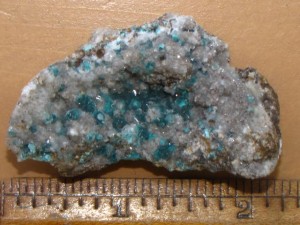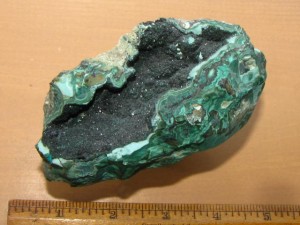The following is from this link http://all-geo.org/erratics/2011/02/cu-the-finale/
SM: It might help some here get a handle on the various copper minerals. I have done the colour coding. So far at W we have azurite and malachite and bornite. We want chalcopyrite and chalcocite!! - maybe primary bornite too.
The talk as per the limk
"What are the relationships between copper and other minerals such as chalcopyrite, cuprite, chrysocolla, bornite, malachite, and azurite, magnetite, and hematite, among others?
First, a word or two (I am not making these up!) about hypogene and supergene processes
Primary minerals are those that form by the combination of elements rather than by alteration of a mineral. Primary or hypogene minerals in a hydrothermal system can be extensively altered when exposed to oxygen in the near-surface environment.
Pyrite crystals
Pyrite (FeS2), reacting with oxygenated groundwater, will form iron hydroxides and release the sulfur as sulfuric acid.
Chalcopyrite (CuFeS2), reacting with dissolved atmospheric oxygen and carbon dioxide, can produce cuprite (Cu2O) and siderite (FeCO3).
Chalcocite (Cu2S) commonly forms from the alteration of primary copper minerals that are attacked above the water table by oxygen.
The net result of these and related reactions is to oxidize the metals found in the sulfides to form oxides, hydroxides, carbonates, and sulfates. Because these reactions produce oxygen-bearing minerals at the expense of sulfides, the near surface zone is often referred to as the oxidized zone and the minerals produced are called supergene or secondary minerals.
Next is a simple listing of mineral names with each appropriate chemical formula. These formulas tie a nice neat bow on the whole copper mineralization concept. I hope you agree!
Common sulfide ores for copper include:
Bornite - Cu5FeS4, Copper Iron Sulfide
Chalcocite - Cu2S, Copper Sulfide
Chalcopyrite - CuFeS2, Copper Iron Sulfide the most common ore.
Covellite - CuS, Copper Sulfide – an excellent ore of copper when available in economic amounts.
Aurichalcite
Copper carbonates include:
Aurichalcite (Zn, Cu)5(CO3)2(OH)6, Zinc Copper Carbonate Hydroxide forms in the oxidation zones of zinc-copper deposits where it is deposited by circulating fluids of carbonate-rich solutions.
Azurite
Azurite - Cu3(CO3)2(OH)2, Copper Carbonate Hydroxide considered a minor ore of copper, mostly because it is found associated with other more valuable copper ores.
Outer Malachite w/ inner Chrysacolla
Malachite - Cu2(CO3)(OH)2, Copper Carbonate Hydroxide
Copper oxides include:
Cuprite - Cu2O, Copper Oxide Of all the copper ores except for native copper, cuprite gives the greatest yield of copper per molecule since there is only one oxygen atom to every two copper atoms.
Cuprite is found in the near-surface oxidized portion of copper-bearing hydrothermal sulfide deposits. It generally is produced by the alteration and oxidation of primary sulfide minerals such as chalcopyrite.
Copper silicates include:
Chrysocolla - (Cu,Al)2H2Si2O5(OH)4· nH2O, Hydrous Copper Silicate found in the oxidation zone of copper deposits; associated with azurite, malachite, and cuprite. It is an important surface indicator pinpointing the presence of disseminated copper deposits (porphyry copper ore) However, it is not an important copper ore.
- Forums
- ASX - By Stock
- Ann: Corporate Presentation
The following is from this link...
-
-
- There are more pages in this discussion • 15 more messages in this thread...
You’re viewing a single post only. To view the entire thread just sign in or Join Now (FREE)
Add AUR (ASX) to my watchlist
 (20min delay) (20min delay)
|
|||||
|
Last
0.7¢ |
Change
0.000(0.00%) |
Mkt cap ! $2.383M | |||
| Open | High | Low | Value | Volume |
| 0.7¢ | 0.7¢ | 0.7¢ | $9 | 1.324K |
Buyers (Bids)
| No. | Vol. | Price($) |
|---|---|---|
| 1 | 300000 | 0.6¢ |
Sellers (Offers)
| Price($) | Vol. | No. |
|---|---|---|
| 0.7¢ | 664068 | 4 |
View Market Depth
| No. | Vol. | Price($) |
|---|---|---|
| 2 | 103729 | 0.030 |
| 1 | 218636 | 0.028 |
| 1 | 300000 | 0.024 |
| 2 | 200000 | 0.022 |
| 1 | 100000 | 0.020 |
| Price($) | Vol. | No. |
|---|---|---|
| 0.031 | 20000 | 1 |
| 0.034 | 194955 | 1 |
| 0.035 | 665000 | 1 |
| 0.036 | 58747 | 1 |
| 0.039 | 82835 | 1 |
| Last trade - 11.47am 15/11/2024 (20 minute delay) ? |
| AUR (ASX) Chart |













